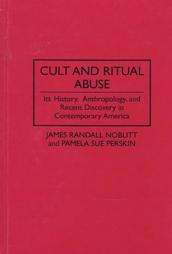Cult and Ritual Abuse
|
1995 first edition cover | |
| Author | Randy Noblitt and Pamela Perskin |
|---|---|
| Country | United States |
| Language | English |
| Subject | Satanic ritual abuse |
| Genre | Non-fiction |
| Publisher | Praeger Publishing |
Published in English | 1995/2000 |
| Media type | Hardcover |
| Pages |
225 (1st ed.) 269 (2nd ed.) |
| ISBN |
0-275-95281-9 (1st ed.) 027596664X (2nd ed.) |
Cult and Ritual Abuse: Its History, Anthropology, and Recent Discovery in Contemporary America is a book written by James Randall Noblitt and Pamela Sue Perskin exploring the phenomenon of satanic ritual abuse. The authors argue that some allegations of intergenerational, ritualized abuse cults are supported by evidence, contrary to most scholars of the subject who regard satanic ritual abuse as a moral panic with no factual basis.[1] Noblitt, a clinical psychologist, is Director of the Center for Counseling and Psychological Services in Dallas, Texas. Perskin is the Executive Director of the International Council on Cultism and Ritual Trauma and a lecturer on child abuse.
Cult and Ritual Abuse was first published in 1995; a revised edition followed in 2000. The book has been called the most reasonable review of the pro-conspiracy version of satanic ritual abuse to date, but was also criticized for being incoherent, inconsistent, uneven, filled with logical fallacies and for citing proven frauds as evidence.
Reviews
Both editions of the book have been reviewed several times.
First edition
Joel Best described it as having the "trappings" of a scholarly book, but as ultimately incoherent. He pointed out that even Noblitt & Perskin state their evidence is not compelling, and, despite acknowledging the need for parsimony as in Occam's razor (i.e., favoring the simplest explanation that accounts for the evidence), the authors accept the less parsimonious proposition: that multigenerational, multinational abusive entities exist and have existed for centuries without discovery, rather than the more parsimonious idea that the patients are disturbed, malingering or mistaken. Best also drew attention to special pleading used by Noblitt and Perskin to support the stories of their patients. Best concluded that in order to understand the debate regarding satanic ritual abuse one must read the sceptical literature.[2]
LeRoy Schultz, Professor Emeritus of social work at West Virginia University, described the book as a very selective review of the literature on satanic ritual abuse, citing only work that supports their point of view, and failing to address the issue of clinical versus empirical evidence.[3]
A review in the American Journal of Psychotherapy stated that the book was probably the most reasonable review of the subject to date.[4]
Second edition
Two reviews of the second edition refer to the book as an overview of the topic, and as a vehicle to advocate for the inclusion of cult and ritual trauma abuse in the DSM.[5][6]
Edward L. King reviewed the book from a Freemason's perspective. He pointed out that Noblitt and Perskin cite known frauds, including Michael Warnke's disproven involvement in satanism and the Taxil hoax, without qualification or noting that these examples were faked. King also pointed to the dubiousness of Noblitt's qualifications and certifications, concluding that he considers the book an utter fraud and that what "[Noblit and Perskin] consider "research" is merely a self-serving screed designed to enhance their so-called 'professional' status as treating "satanic ritual abuse."[7]
Editions
- Perskin, Pamela Sue; Noblitt, James Randall (1995). Cult and ritual abuse : its history, anthropology, and recent discovery in contemporary America. New York: Praeger Publishing. p. 225. ISBN 0-275-95281-9.
- Perskin PS, Noblitt JR (2000). Cult and ritual abuse: its history, anthropology, and recent discovery in contemporary America. New York: Praeger Publishing. p. 269. ISBN 0-275-96664-X.
References
- ↑ See:
- de Young, Mary (2004). The Day Care Ritual Abuse Moral Panic. Jefferson, North Carolina, United States: McFarland and Company. ISBN 0-7864-1830-3.
- Edge PW (2001). Legal Responses to Religious Difference. Berlin: Springer. pp. 362–3. ISBN 90-411-1678-8.
- Faller KC (2003). Understanding and assessing child sexual maltreatment. Thousand Oaks: Sage Publications. pp. 29–33. ISBN 0-7619-1996-1.
- Frankfurter, D (2006). Evil Incarnate: Rumors of Demonic Conspiracy and Ritual Abuse in History. Princeton, NJ: Princeton University Press. ISBN 0-691-11350-5.
- LaFontaine JS (1998). Speak of the Devil: allegations of satanic abuse in Britain. Cambridge, UK: Cambridge University Press. ISBN 0-521-62934-9.
- Nathan, D; Snedeker M (1995). Satan's Silence: Ritual Abuse and the Making of a Modern American Witch Hunt. Basic Books. ISBN 0-87975-809-0.
- Perrin RD, Miller-Perrin CL (2006). Child maltreatment: an introduction. Thousand Oaks: Sage Publications. pp. 318–21. ISBN 1-4129-2668-8.
- Victor JS (1993). Satanic Panic: The Creation of a Contemporary Legend. Open Court Publishing Company. ISBN 0-8126-9192-X.
- ↑ Best, Joel (1996). "Book Review: Cult and Ritual Abuse: Its History, Anthropology, and Recent Discovery in Contemporary America". Criminal Justice Review. 21: 103. doi:10.1177/073401689602100119.
- ↑ Schultz, L (1995). "Book Review: Cult and Ritual Abuse: Its History, Anthropology and Recent Discovery in Contemporary America". Issues in Child Abuse Accusations. 7 (4).
- ↑ Coomaraswamy,, R. (Summer 1996). "Cult and Ritual Abuse: Its History, Anthropology and Recent Discovery in Contemporary America". American Journal of Psychotherapy. 50 (3): 383.
- ↑ Fletcher, K. (July 2001). "Cult and ritual abuse: Its history, anthropology, and recent discovery in contemporary America, revised edition". Psychiatric services. 52 (7): 978–979. doi:10.1176/appi.ps.52.7.978.
- ↑ Schmuttermaier, J.R. (2001). "Cult and Ritual Abuse: Sadism not Sophism". Contemporary Psychology: the APA Review of Books. 46 (6): 615–617.
- ↑ King, EL. "Book review: Cult & Ritual Abuse - Its History, Anthropology, and Recent Discovery in Contemporary America". Retrieved 2009-04-05.
